-
New Year… New Plan! (Part 3 – Plan, do, check, act, repeat)
Date posted:
-
-
-
Post Author
Philip SharmanIFRF Director
-

-
In the first two IFRF blog posts on this topic (‘Part 1 – Review Position’ and ‘Part 2 – Refresh Strategy’ ) we began to ‘roll-out’ the results of our Strategic Review of IFRF as at the end of 2018 (‘SR 2018’) and, alongside it, outline a new strategy for a Three-Year Plan to take IFRF into the next decade (‘TYP 2019-2021’).
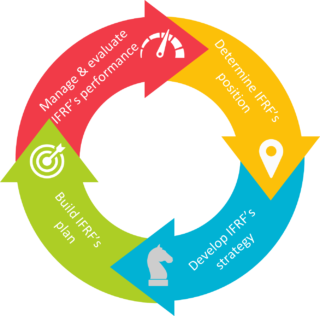
So far, we have shared the ‘outputs’ of the first two stages of our four-stage strategic planning process, namely ‘Stage 1 – Determine IFRF’s Position’ (addressing the question “Where are we now?”) and ‘Stage 2 – Develop IFRF’s Strategy’ (addressing the follow-up question “Where do we want to be?”). These two stages form the main pillars of SR 2018, an exercise that we intend to repeat at the end of 2021.
In this latest blog post we move on to look at Stages 3 and 4: ‘Stage 3 – Build IFRF’s plan’ (seeking to answer the question “How will we get there and who must do what?”) and ‘Stage 4 – Manage and evaluate IFRF’s performance’ (the ‘acid test’ of “How are we doing?”). These latter two stages form the main pillars of TYP 2019-2021 and are essentially an annual process but with an element of continuous refinement. These two stages, together, fulfil the “plan, do, check, act” mantra that underlies any effective strategic planning.
So, let’s have a look at the outputs of Stages 3 and 4…
How will we get where we want to be and who must do what? IFRF’s new three-year plan
In planning how IFRF will move from where it is now to where we have decided we want it to be (as expressed in our ‘vision’ of what success looks like over a five-year timeframe – see previous blog post), the Delivery Team and IFRF Council undertook the tasks listed in the slide below:

Setting priorities for the three-year period of the plan based on the outputs of our position analysis (Stage 1) and strategy development (Stage 2) activities required us to consider every aspect of IFRF’s structure, strategy, governance and operations. These various ‘aspects’ of IFRF are shown in the diagrams below.

By carefully considering each of these aspects in the light of the various ‘additive’ outputs from stages 1 and 2 – particularly the agreed set of objectives for 2019-2021 and the financial forecast – a set of 42 ‘SMART’ (i.e. specific, measurable, achievable, realistic and time-bound) organisation goals for the three-year period were developed, with target delivery years specified for each.
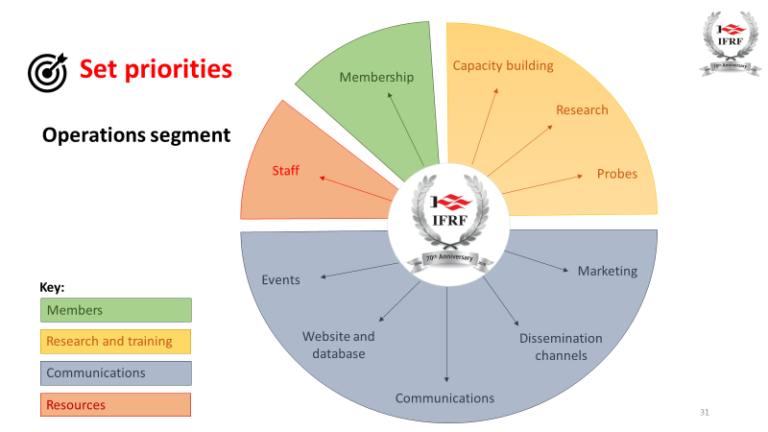
These goals for IFRF over the period 2019-2021 are listed in the table below.
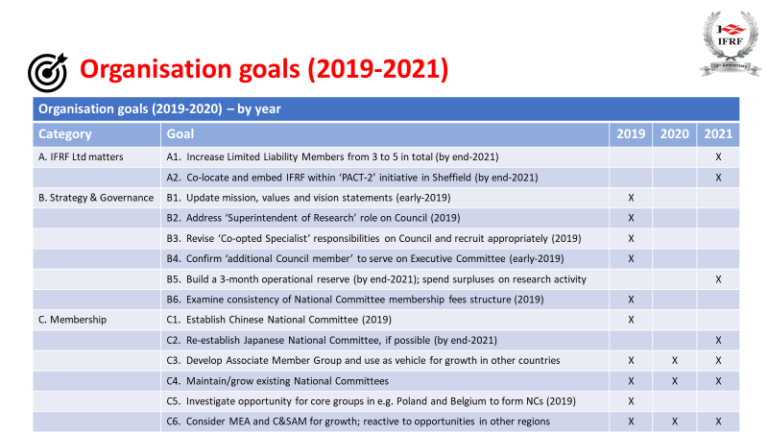

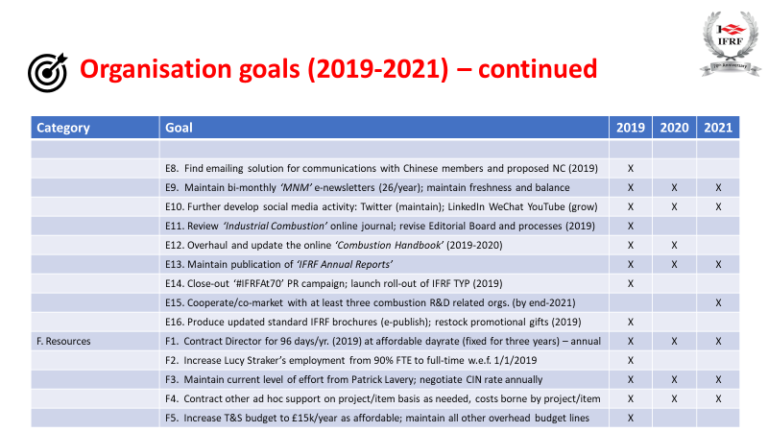
Having established these goals, the next step was to set a manageable number of ‘key performance indicators’ (KPIs) to enable progress against these goals to be tracked effectively. A total of 13 such KPIs have been agreed by IFRF Council as listed below.

The organisation goals have been assigned to individual delivery team members (or more than one, if appropriate, with one identified as ‘owning’ the goal). These team member (annual) goals will be used in performance reviews of the team members/contractors.
Finally, a budget for 2019 (and indicative financial plans for 2020 and 2021), aligned with the plan, has been agreed with the Executive Committee of IFRF.
How are we doing? Managing and evaluating IFRF’s performance
A key part of any effective strategic planning process is to have the means for managing the execution of the plan and regularly evaluating the organisation’s performance in delivery. The mechanism and schedule for reviewing progress against the plan, adapting the plan in the light of such reviews, and updating it at the year-end for the ready for the subsequent year are key elements for consideration, and the activities associated with Stage 4 are shown in the slide below.
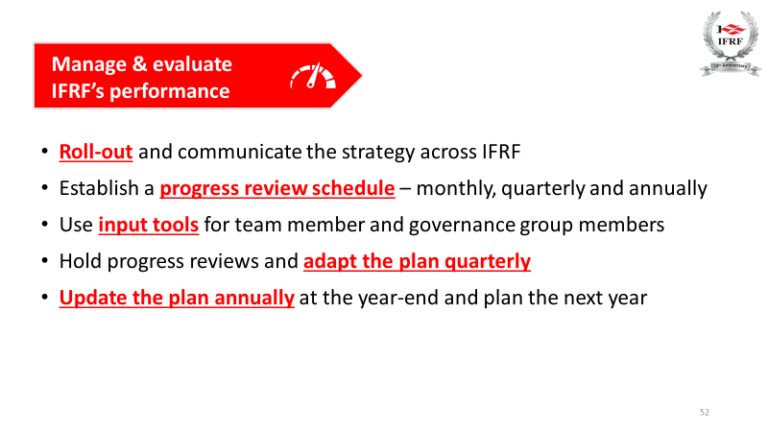
The first prerequisite for assessing how we are doing in terms of delivery is to ensure that there is an effective roll-out and transparent communication of IFRF’s longer-term strategy and three-year plan across the organisation. This has been the purpose of this mini blog series, which will be followed-up with a collated document posted on the IFRF website and dissemination via our various social media channels.
A progress review process and schedule were put in place from the outset of IFRF being based in the UK (i.e. from January 2017): A three-tier reporting and governance structure of monthly reviews of the delivery team’s progress by IFRF’s General Secretary, quarterly reviews by the Executive Committee, bi-annual reviews by IFRF Council, and annual preparation and agreement (by Council) of a subsequent one-year plan in the 4th quarter of each year and publication of an agreed ‘infographic-style’ Annual Report (including IFRF’s annual management accounts) within six months of the year-end.
Supporting this, a range of efficient input tools have been put in place to enable delivery team, ExCo and Council inputs: These include regular web meetings, shared Google Doc planning tables and ‘dashboard-style’ progress indicators, infographic-style Quarterly Progress Report slide packs, and annual planning and budgeting cycle documentation.
The established review schedule and input tools enable the plan to be adapted quarterly, and an updated Annual Plan to be developed and agreed with Council at the year-end ready for the following year. At the end of the third year in the cycle a new TYP will be prepared and presented to Council for agreement. A Strategic Review may be conducted at this juncture, if appropriate.
So, there we are… now comes the tough bit – delivering it!
